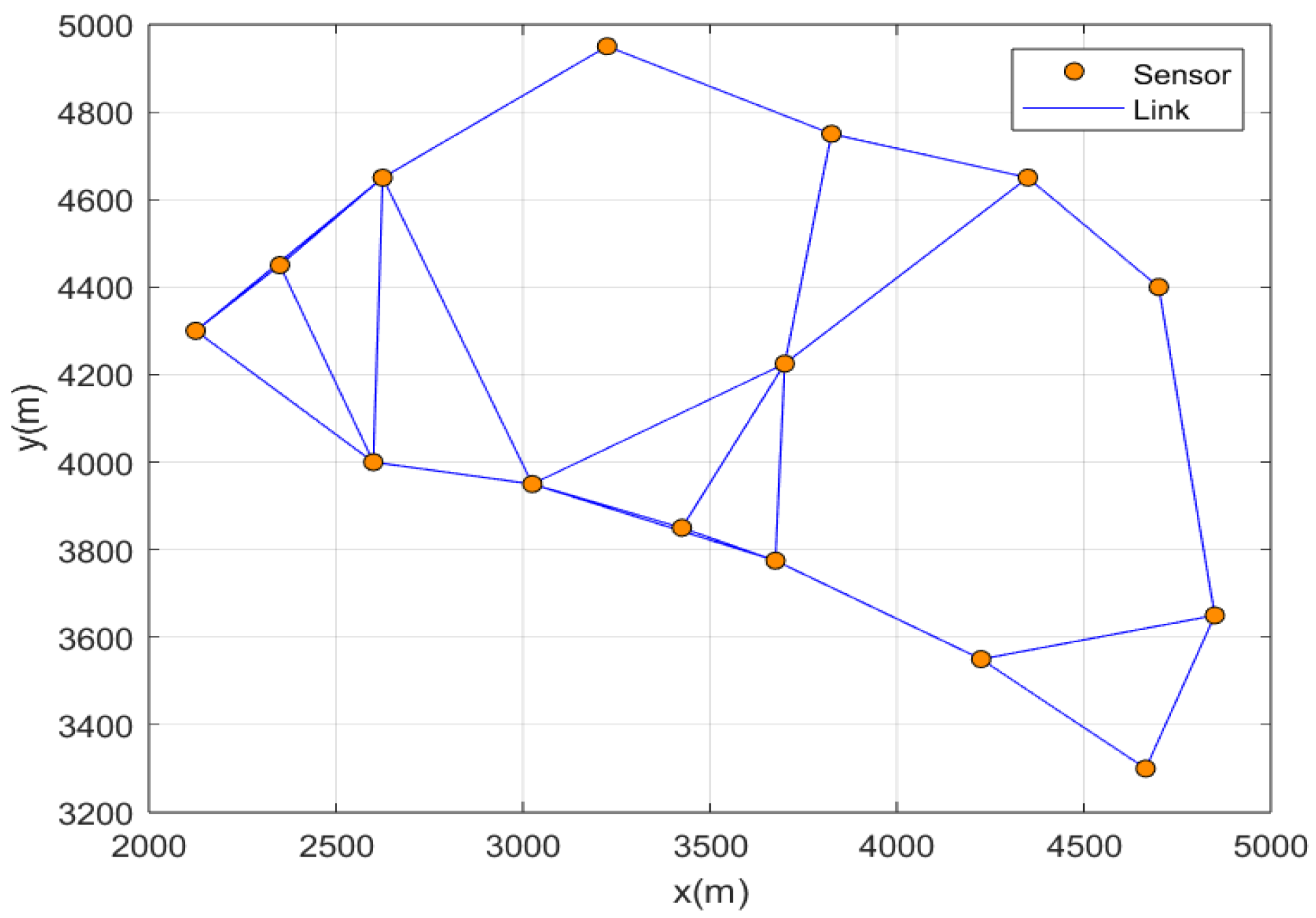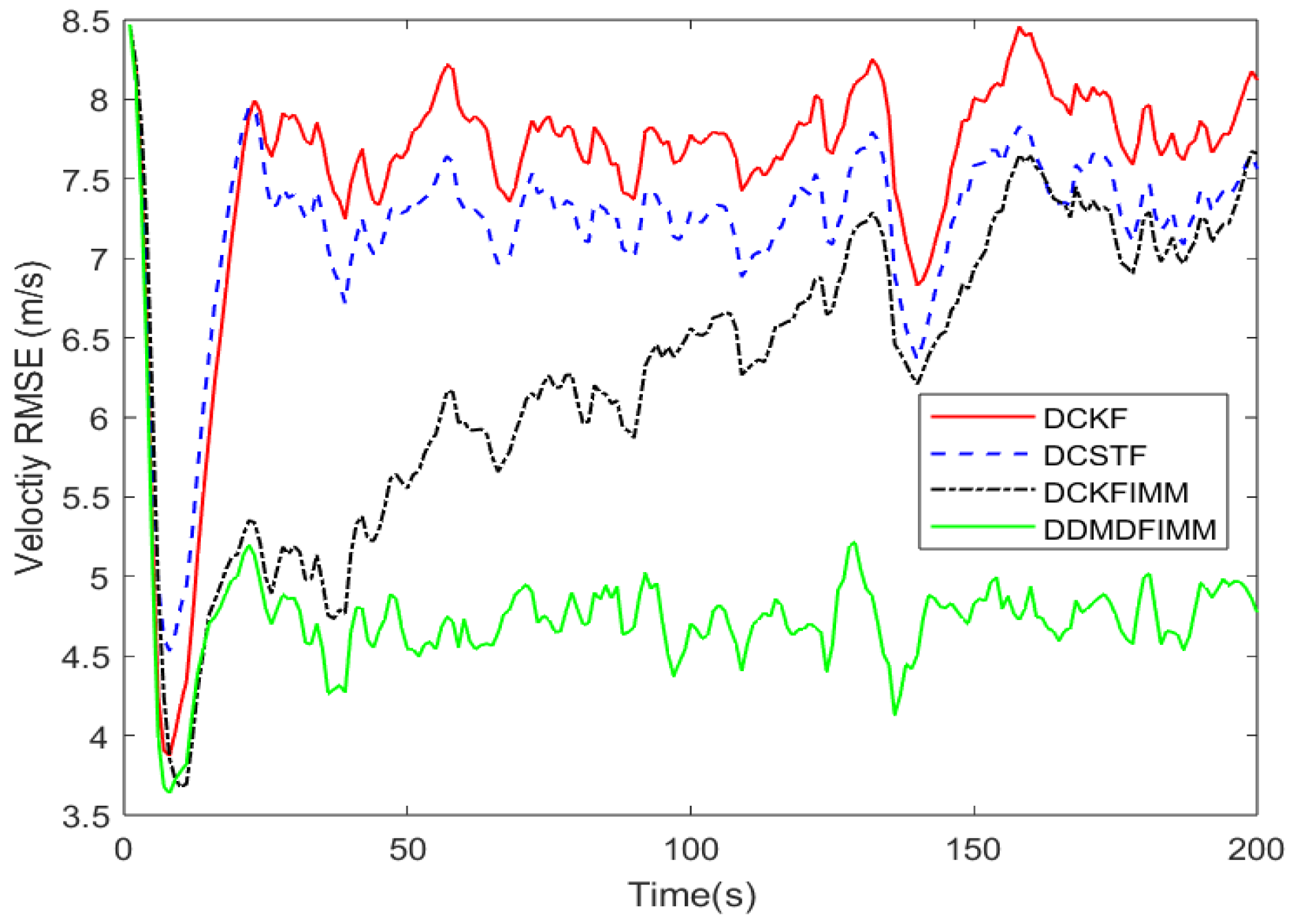Distributed Diffusion Multi-Distribution Filter with IMM for Heavy-Tailed Noise
Abstract
1. Introduction
- (1)
- The integration of a multi-noise distribution filter with the IMM algorithm enhances fidelity to realistic tracking scenarios characterized by predominantly maneuvering targets and heavy-tailed observation noise.
- (2)
- The diffusion algorithm used is robust and insensitive to local deviations caused by outliers, resulting in greater accuracy.
- (3)
- The simulation verifies the functionality of the designed filter.
2. Preliminaries and Problem Formulation
2.1. Modeling
2.2. Multi-Noise Distribution
3. Distribution Diffusion Multi-Distribution Filtering of IMM
3.1. ATC-Diffusion Multi-Distribution Filtering
3.2. DDMD Filtering of IMM
3.3. The DDMDIMM Filter
- (1)
- Time update
- (2)
- Measurement update
- (1)
- Time update
- (2)
- Measurement update
- Step 1 Input interacting
- Step 2 Parallel filtering
- Step 3 Calculate distribution probability
- Step 4 Fuse the mixed PDF
- Step 5 diffusion on fused PDF
- Step 6 Calculate model probability
- Step 7 Output extraction
| Algorithm 1: Distributed diffusion multi-distribution of IMM filter. |
Haven the initial values , , for and for and the dof for each iteration k at each node i, starting the following iteration Gaussian: , Student-t: , |
4. Numerical Simulation
5. Conclusions
Author Contributions
Funding
Data Availability Statement
Conflicts of Interest
References
- Bar-Shalom, Y. Multitarget Tracking: Applications and Advances; Artech House: Boston, MA, USA, 2000. [Google Scholar]
- Reif, K.; Gunther, S.; Yaz, E.; Unbehauen, R. Stochastic stability of the discrete-time extended Kalman filter. IEEE Trans. Autom. Control. 1999, 44, 714–728. [Google Scholar] [CrossRef]
- Julier, S.; Uhlmann, J.; Durrant-Whyte, H.F. A new method for the nonlinear transformation of means and covariances in filters and estimators. IEEE Trans. Autom. Control 2000, 45, 477–482. [Google Scholar] [CrossRef]
- Shen, K.; Dong, P.; Jing, Z.; Leung, H. Consensus-Based Labeled Multi-Bernoulli Filter for Multitarget Tracking in Distributed Sensor Network. IEEE Trans. Cybern. 2022, 52, 12722–12733. [Google Scholar] [CrossRef]
- Battistelli, G.; Chisci, L. Kullback–Leibler average, consensus on probability densities, and distributed state estimation with guaranteed stability. Automatica 2014, 50, 707–718. [Google Scholar] [CrossRef]
- Cattivelli, F.S.; Sayed, A.H. Diffusion strategies for distributed Kalman filtering and smoothing. IEEE Trans. Autom. Control 2010, 55, 2069–2084. [Google Scholar] [CrossRef]
- Hu, J.; Xie, L.; Zhang, C. Diffusion Kalman filtering based on covariance intersection. IEEE Trans. Signal Process. 2012, 60, 891–902. [Google Scholar] [CrossRef]
- Li, X.R.; Jilkov, V. Survey of maneuvering target tracking. Part V: Multiple-model methods. IEEE Trans. Aerosp. Electron. Syst. 2005, 41, 1255–1320. [Google Scholar] [CrossRef]
- Zhu, H.; Zhang, G.; Li, Y.; Leung, H. A novel robust Kalman filter with unknown non-stationary heavy-tailed noise. Automatica 2021, 127, 109511. [Google Scholar] [CrossRef]
- Bishop, C.M. Recognition and Machine Learning (Information Science and Statistics); Springer: New York, NY, USA, 2006. [Google Scholar]
- Arulampalam, M.; Maskell, S.; Gordon, N.; Clapp, T. A tutorial on particle filters for online nonlinear/non-Gaussian Bayesian tracking. IEEE Trans. Signal Process. 2002, 50, 174–188. [Google Scholar] [CrossRef]
- Chen, B.; Liu, X.; Zhao, H.; Principe, J.C. Maximum correntropy Kalman filter. Automatica 2017, 76, 70–77. [Google Scholar] [CrossRef]
- Ma, Y.; Zhao, S.; Huang, B. Multiple-Model State Estimation Based on Variational Bayesian Inference. IEEE Trans. Autom. Control 2019, 64, 1679–1685. [Google Scholar] [CrossRef]
- Zhu, H.; Zhang, G.; Li, Y.; Leung, H. An Adaptive Kalman Filter With Inaccurate Noise Covariances in the Presence of Outliers. IEEE Trans. Autom. Control 2022, 67, 374–381. [Google Scholar] [CrossRef]
- Huang, Y.; Zhang, Y.; Li, N.; Wu, Z.; Chambers, J.A. A Novel Robust Student’s t-Based Kalman Filter. IEEE Trans. Aerosp. Electron. Syst. 2017, 53, 1545–1554. [Google Scholar] [CrossRef]
- Wang, G.; Yang, C.; Ma, X. A Novel Robust Nonlinear Kalman Filter Based on Multivariate Laplace Distribution. IEEE Trans. Circuits Syst. II Exp. Briefs. 2021, 68, 2705–2709. [Google Scholar] [CrossRef]
- Huang, Y.; Zhang, Y.; Shi, P.; Chambers, J. Variational Adaptive Kalman Filter With Gaussian-Inverse-Wishart Mixture Distribution. IEEE Trans. Autom. Control 2021, 66, 1786–1793. [Google Scholar] [CrossRef]
- Youn, W.; Huang, Y.; Myung, H. Outlier-Robust Student’s-t-Based IMM-VB Localization for Manned Aircraft Using TDOA Measurements. IEEE/ASME Trans. Mechatronics 2020, 25, 1646–1658. [Google Scholar] [CrossRef]
- Xie, G.; Sun, L.; Wen, T.; Hei, X.; Qian, F. Adaptive Transition Probability Matrix-Based Parallel IMM Algorithm. IEEE Trans. Syst. Man Cybern. Syst. 2021, 51, 2980–2989. [Google Scholar] [CrossRef]
- Wang, G.; Wang, X.; Zhang, Y. Variational Bayesian IMM-Filter for JMSs With Unknown Noise Covariances. IEEE Trans. Aerosp. Electron. Syst. 2020, 56, 1652–1661. [Google Scholar] [CrossRef]
- Youn, W.; Huang, Y.; Myung, H. Robust Localization Using IMM Filter Based on Skew Gaussian-Gamma Mixture Distribution in Mixed LOS/NLOS Condition. IEEE Trans. Instrum. Meas. 2020, 69, 5166–5182. [Google Scholar] [CrossRef]
- Blom, H.; Bar-Shalom, Y. The interacting multiple model algorithm with Markovian switching coefficients. IEEE. Trans. Autom. Control 1988, AC-33, 780–783. [Google Scholar] [CrossRef]
- Hwang, I.; Seah, C.E.; Lee, S. A Study on Stability of the Interacting Multiple Model Algorithm. IEEE Trans. Autom. Control 2017, 62, 901–906. [Google Scholar] [CrossRef]
- Cui, T.; Jing, Z.; Dong, P. Variational Bayesian Multiple Model Filter in the Presence of Outliers. IEEE Sens. J. 2024, 24, 12985–12994. [Google Scholar] [CrossRef]
- Huang, Y.; Zhang, Y.; Zhao, Y.; Chambers, J.A. A novel robust Gaussian-student’s T mixture distribution based Kalman filter. IEEE Trans. Signal Process. 2019, 67, 3606–3620. [Google Scholar] [CrossRef]
- Bruno, M.; Dias, S. A Bayesian interpretation of distributed diffusion filtering algorithms [Lecture Notes]. IEEE Signal Process. Mag. 2018, 35, 118–123. [Google Scholar] [CrossRef]
- Chang, G.; Fu, W.; Song, L.; Cui, T.; Dong, P. Distributed Consensus Multi-Distribution Filter for Heavy-Tailed Noise. J. Sens. Actuator Netw. 2024, 13, 38. [Google Scholar] [CrossRef]
- Hage, J.; Xu, P.; Bonnifait, P. Student’s t information filter with adaptive degree of freedom for multi-sensor fusion. In Proceedings of the 2019 22th International Conference on Information Fusion (FUSION), Ottawa, ON, Canada, 2–5 July 2019; IEEE: New York, YK, USA, 2019. [Google Scholar]








| DCKF | DCSTF | DCKFIMM | DDMDFIMM | |
|---|---|---|---|---|
| RMSE | 27.0767 | 21.9831 | 21.2361 | 9.7129 |
| TIME | 0.3042 | 0.1466 | 0.5061 | 1.8484 |
| DCKF | DCSTF | DCKFIMM | DDMDFIMM | |
|---|---|---|---|---|
| RMSE | 34.7188 | 17.7127 | 16.6515 | 12.1128 |
| TIME | 0.3031 | 0.1450 | 0.4971 | 1.8303 |
Disclaimer/Publisher’s Note: The statements, opinions and data contained in all publications are solely those of the individual author(s) and contributor(s) and not of MDPI and/or the editor(s). MDPI and/or the editor(s) disclaim responsibility for any injury to people or property resulting from any ideas, methods, instructions or products referred to in the content. |
© 2025 by the authors. Licensee MDPI, Basel, Switzerland. This article is an open access article distributed under the terms and conditions of the Creative Commons Attribution (CC BY) license (https://creativecommons.org/licenses/by/4.0/).
Share and Cite
Chang, G.; Jiang, C.; Fu, W.; Cui, T.; Dong, P. Distributed Diffusion Multi-Distribution Filter with IMM for Heavy-Tailed Noise. Signals 2025, 6, 37. https://doi.org/10.3390/signals6030037
Chang G, Jiang C, Fu W, Cui T, Dong P. Distributed Diffusion Multi-Distribution Filter with IMM for Heavy-Tailed Noise. Signals. 2025; 6(3):37. https://doi.org/10.3390/signals6030037
Chicago/Turabian StyleChang, Guannan, Changwu Jiang, Wenxing Fu, Tao Cui, and Peng Dong. 2025. "Distributed Diffusion Multi-Distribution Filter with IMM for Heavy-Tailed Noise" Signals 6, no. 3: 37. https://doi.org/10.3390/signals6030037
APA StyleChang, G., Jiang, C., Fu, W., Cui, T., & Dong, P. (2025). Distributed Diffusion Multi-Distribution Filter with IMM for Heavy-Tailed Noise. Signals, 6(3), 37. https://doi.org/10.3390/signals6030037







